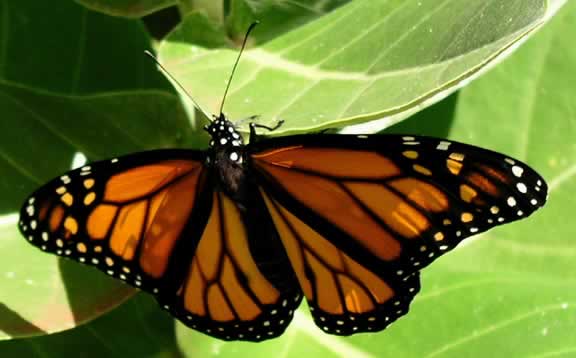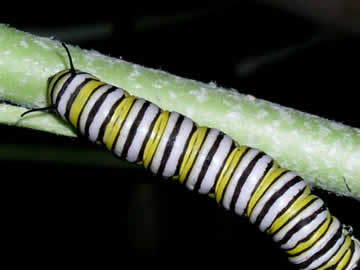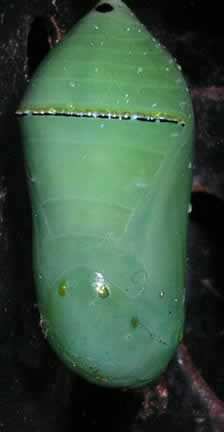|
|
Canku Ota |
|
|
(Many Paths) |
||
|
An Online Newsletter Celebrating Native America |
||
|
December 13, 2003 - Issue 102 |
||
|
|
||
|
METAMORPHOSIS into a Beautiful Delicate Butterfly |
||
|
by Suzanne Westerly
|
||
|
credits: all
photos courtesy of Suzanne Westerly
|
|
I was thrilled to find out that there is a tree next to my house with crown flowers which is in the milkweed family, and that is what monarch butterfly's need for food and laying their eggs on. First I noticed the cute colorful and plump caterpillar chomping on the leaves of my tree, so I grabbed my camera. (Another milky flowering tree in Hawaiíi that the Monarchs like is the plumeria. Both of these flowers are used in leis). The little eggs hatch in 3 to 5 days and the tiny, 1/8th" long caterpillar eats its way out of the egg, and then works on eating the crown flower leaf its egg was laid on.
(Pupa is the nonfeeding stage between the larva and adult, during which the larva undergoes complete transformation within a protective chrysalis). Notice the caterpillars chubby little legs - there are eight pairs. What a life, all it does now is eat nonstop until it's too big for its skin, so it sheds its old skin, eats it, and then continues to eat more milky leaves. After 15 days of eating and eating, the caterpillar is more than 3,000 times heavier than the egg it came from! It does this molting 4 times until it's ready to change into its 3rd stage of development.
Look at how very beautiful the chrysalis is with its glittering gold and black dots. Inside, a miracle is happening. It will take 10 days for the complete metamorphosis. By day 7 the chrysalis changes and you can see the dark orange and black of the wings. In 10-12 days the chrysalis is perfectly translucent and then . . . BUTTERFLY STAGE: the chrysalis skin splits and the butterfly emerges a bit damp and crumpled as it pumps liquid from its swollen abdomen into the black veins of its wings to stiffen them. While the wings are still wet, the butterfly can be moved to a leaf without hurting it. You can see there are two pairs of wings, which are covered with dust-fine scales, which overlap like shingles on a roof so that it can shed rain. Its tongue has become a coiled tube, because it doesn't chew like when it was a caterpillar, now it sips nectar from flowers. The sugar in the nectar is turned into fat - like all the sugar beings eat. The Monarch uses this fat to give them energy on their long flight south. After about an hour of hanging out and drying, the butterfly starts with short flights until it is strong enough to fly over 2,000 miles! While the moist, soft butterfly was hanging there, I was worried that if I wasn’t there to keep the birds that might want to eat it away, it wouldn’t live long. Then I found out from reading that for its entire life cycle, the Monarch is poisonous for predators. The toxins from their milky weed diet gives the caterpillar and butterfly this defense, so they need no camouflage. Did you know that many animals advertise their poisonous nature with bright colors? Monarchs that live east of the Rocky Mountains fly to Mexico in great flocks. It takes them two months to reach their winter home, which is about 75 miles from Mexico City, high up in the mountains. I’m not sure if the Hawai’ian butterflies also come from Mexico. In late April or early May they begin their migration north, mating along the way. The female lays eggs along her journey north, just one egg on each leaf, but 300 leafs! The life span of an actively reproducing Monarch butterfly is only 2 to 5 weeks. Three generations of butterflies will live and die during the summer breeding season. The fourth and final generation doesn't reproduce until they fly back to their great-great grandparents wintering grounds. I hope you had as much fun learning about the Monarch as I did. To view more pictures of the Monarch Butterfly and its various life stages, click here |
|
|
||
|
|
||
| Canku Ota is a free Newsletter celebrating Native America, its traditions and accomplishments . We do not provide subscriber or visitor names to anyone. Some articles presented in Canku Ota may contain copyright material. We have received appropriate permissions for republishing any articles. Material appearing here is distributed without profit or monetary gain to those who have expressed an interest. This is in accordance with Title 17 U.S.C. Section 107. | ||
|
Canku Ota is a copyright © 2000, 2001, 2002, 2003 of Vicki Lockard and Paul Barry. |
||
 |
 |
|
|
The "Canku Ota - A Newsletter Celebrating Native America" web site and its design is the |
||
|
Copyright © 1999, 2000, 2001, 2002, 2003 of Paul C. Barry. |
||
|
All Rights Reserved. |
||
 Every
year in winter, Monarch butterflies return to North America and
Hawai'i from Mexico, mate and lay their eggs on leaves.
Every
year in winter, Monarch butterflies return to North America and
Hawai'i from Mexico, mate and lay their eggs on leaves.
 LARVAL
STAGE: The caterpillar grows to 2" long before it pupates in
a jade and emerald green chrysalis - what most people call a cocoon.
LARVAL
STAGE: The caterpillar grows to 2" long before it pupates in
a jade and emerald green chrysalis - what most people call a cocoon. CHRYSALIS
STAGE: Now this 2" chubby caterpillar must find a place to
begin the next part of its metamorphosis, the chrysalis stage. The
caterpillar looks for a firm place out of the wind and rain. This
little guy used an old bbq grill. On it's lower lip is a body part
called a spinneret. This is how the caterpillar spins a sticky,
silky thread. First it spins a small, silky, sticky knob. It hooks
its back feet into the knob and hangs with its head down in a "J"
formation. It splits its larval skin for the last time upward from
the head to the tail. Its new skin is soft and damp, but hardens
as it dries.
CHRYSALIS
STAGE: Now this 2" chubby caterpillar must find a place to
begin the next part of its metamorphosis, the chrysalis stage. The
caterpillar looks for a firm place out of the wind and rain. This
little guy used an old bbq grill. On it's lower lip is a body part
called a spinneret. This is how the caterpillar spins a sticky,
silky thread. First it spins a small, silky, sticky knob. It hooks
its back feet into the knob and hangs with its head down in a "J"
formation. It splits its larval skin for the last time upward from
the head to the tail. Its new skin is soft and damp, but hardens
as it dries.